 |
 |
![]()
| DENTAL OFFICER CAPTAIN WILLIAM J K TRELEAVEN |
| 25 DENTAL UNIT AND "Ä" FORCE |
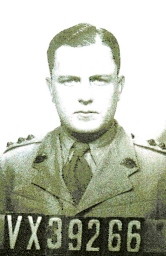 |
William Joseph Kinsella (Bill) Treleaven was born at Clunes, Victoria in 1914 and completed his primary and secondary schooling in Western Australia after his family moved there in 1917. As the University of Western Australia did not offer a dentistry course in the 1930's, Bill undertook his dental science degree at the University of Melbourne, graduating from there in 1936. Bill enlisted in the AMF at South Melbourne in 1940 and in the AIF at Royal Park in 1941. He undertook training at Puckapunyal and Balcombe and was assigned to 25 Australian Army Dental Corps, which as part of the Australian Army 8th Division embarked for Singapore on HMT "EE" ( Marnix Van St. Aldegonde) in July 1941. On arrival at Singapore in August 1941, 25 Dental Unit was based at Birdwood Camp initially, then at Batu Parhat and the General Base Depot at Johore in Malaya, and lastly at 13 Australian General Hospital in Singapore. With the capitulation of Singapore to the Japanese in February 1942, Bill was interned as a prisoner of war at Selarang Barracks, Changi, where he worked as a dentist to other POWs. Below are two sketches. The first sketch shows the Dental Centre as drawn by Corporal Dick Cockram 2/12 Field Company RAE. |
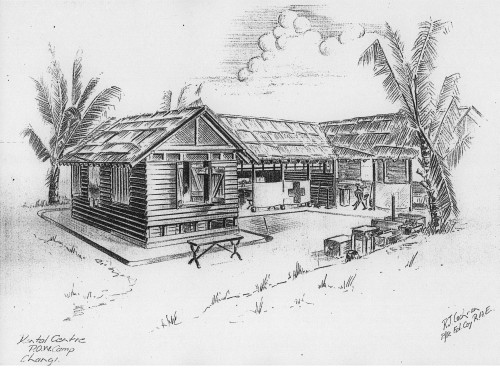
The below sketch by artist Fred Smith shows himself (as Lieutenant Fred Smith) in the chair being treated by Major John Rosson.
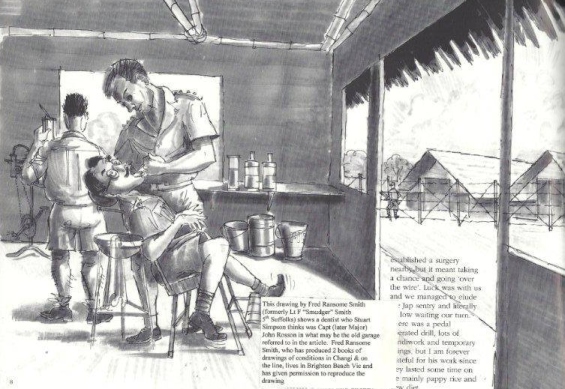
The above drawing has this caption. "The drawing by Fred Ransome Smith (Formerly Lt Fred "Smudger" Smith 5th Suffolks) shows a dentist who Stuart Simpson (Fellow POW Dentist of Brisbane) thinks was Captain (later Major) Rosson, in what may be the old garage in Selerang Barracks". (compare this sketch with the earlier one and it looks like the open section in Dick Cockram's sketch)
Fred Ransome has produced two books of drawings of conditions experienced by the POWs. These books can be purchased from Fred Ransome Smith at 5/33 Holyrood Street, Hampton Victoria 3188 at around $23 each including postage.
In May 1942 and as part of "A" Force Bill Treleaven embarked with 25 Dental Unit on one of the so-called Japanese "hellships," the Celebes Maru, for "destination unknown," ultimately disembarking with one thousand men at Mergui, Burma, under the command of Lt Colonel G Ramsay. Bill worked as a dentist to Australian POWS and Japanese army personnel in Mergui, and it is likely to have been there that he was presented with a bottle of beer from a grateful Japanese officer to whom he had provided dental treatment. Together with other POWs, 25 Dental Unit moved to Tavoy in August 1942 and on to the Burma-Thai railway construction at Thanbyuzayat in December 1942.
In March 1943 whilst at Kunknitway POW Camp, Bill completed the following report to the senior medical officer at Thanbyuzayat POW Camp about his dental rounds in the preceding two-week period. This report was later included as part of the "A" Force War Crimes and Trials Exhibits on the Health of POWS in Burma.
Report on Dental Officer's visit to P.O.W. Camps-25 Feb - 9 Mar 43
It is advised that the above visit has been completed. The camps visited together with the number of men examined and treated are as follows -
Camp No. of men treated Total
1 Reptu 112
2 Tanyin 217 = 559
3 Anarkan 172
4 75 kilo (75% of men from 58
Thetkaw camp)
1 Treatment consisted of-
(a) Limited numbers of extractions, in case of pain only.
(b) Insertion of temporary fillings. In most cases after only a partial removal of caries
2 Filling materials-
(a) Zinc Oxide and Oil of Cloves dressings. Zinc Oxide supplies were exhausted early.
(b) Temporary stopping (Gutta Percha)
3 Condition of teeth-
It was found generally that the teeth of the Australian personnel were in much better condition than the Dutch. Considering the conditions of the last year, the teeth of the Australians are far better than expected.
4 Lack of equipment and supplies-
This requires urgent attention for the following reasons.
(a) As there was no foot engine, it was impossible to perform any work of a permanent nature. Further many cavities were noticed, which were inaccessible with hand instruments.
(b) Shortage of anaesthetic-
Owing to the acute shortage of anaesthetic, teeth were extracted only in cases of pain. Temporary stoppings were inserted in many teeth, which under normal conditions would have been extracted.
Two ounces of cocaine solution and ten ampoules of 1% Novocain were provided by the Nipponese escort (who acted on his own initiative in producing same) but these supplies were quickly exhausted and it is emphasized that much more in the way of Anaesthetic will be required, should a further tour be made.
5 It is requested that immediate steps be taken re the supply of the undermentioned drugs.
(a)Zinc Oxide
Present supplies nil. A white powder, supplied by the various RAP's and labeled as such and recently acquired in response to Medical Officers requests for drugs, was NOT Zinc Oxide but simulates Talcum Powder. Proof of this was obtained, in that on mixing with Oil of Cloves, the resultant mixture would not harden or form any adhesive compound, as in the normal case.
(b) Oil of Cloves.
(c) Gutta Percha. Present supplies nil.
(d) Dental Cements suitable for replacing inlays etc. Present supplies nil
(e) Local Anaesthetic- 2% Novocaine in either solution or tablet form
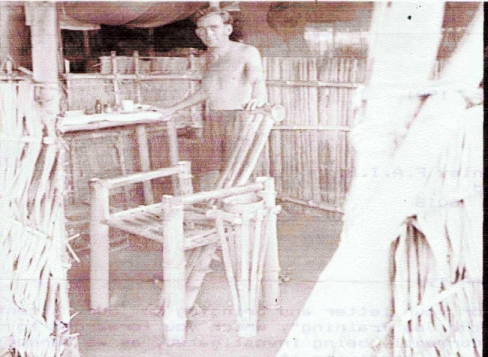 |
Construction of the railway joining Thailand and Burma was completed late 1943. In 1944, 25 Dental Unit was moved to POW base camps (most likely initially to the Kanburi area) in Thailand, and at the start of 1945 to Phetburi Camp in Thailand. The photograph on left is of Private Robert Dalrymple, a member of 25 Dental Unit, standing next to an improvised dental chair at Phetburi camp in Thailand. |
|
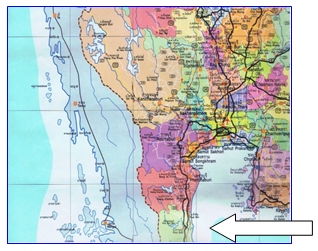 |
It is likely that the specific camps in which Bill was interned are as follows:
Phetburi was situated approx 160 KM south of Bangkok. See arrow on map on left. |
It would be an injustice to not mention the other members of 25 Dental Unit. As far as I can identify them they are shown below.
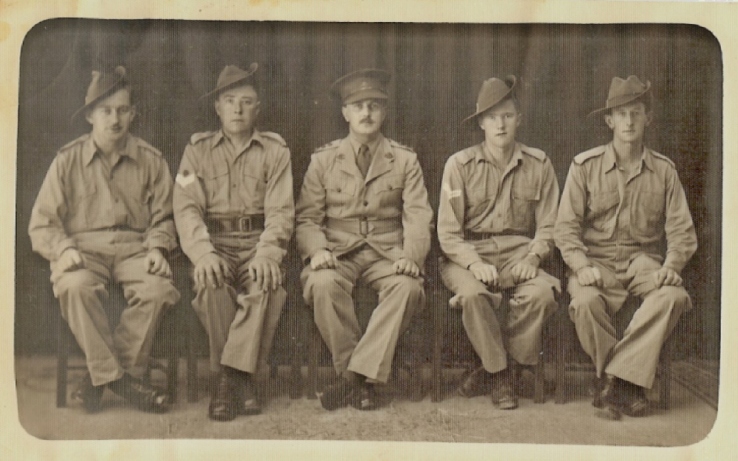
Left to right. Not identified. Staff Sergeant Norman S Hicks (VX39673). Captain Treleaven. Corporal Vincent B McColl VX39663. Not identified. The men who were not identified are likely to have been Private Warren H Lewis VX29066 and Private Robert H Dalrymple VX45955 (also in the earlier picture beside the improvised Dental chair) .
On release as a POW in August 1945 and whilst awaiting repatriation to Australia, Bill was housed with other Australian officers at the Oriental Hotel in Bangkok. It was here that he fell from a first-floor balcony and broke his neck. His parents, then living in Melbourne, who had just been advised that he was "alive in Siam" following Japan's surrender, received word by cable that he was "dangerously ill." However, Bill recovered from the injury and returned to Melbourne on the hospital ship Karoa in November 1945.
Bill encapsulated his experiences as a prisoner of the Japanese in Thailand and Burma in a short account that he wrote for the Assistant Director Dental Services (ADDS), HQ Australian Army Dental Corps, Victoria Line of Communication Area, whilst a patient at the Heidleberg Repatriation Hospital in December 1945.
EXPERIENCES WHILE Ps.W OF 25 DENTAL UNIT
REFERENCE LETTER No. 221620 0F 18 DEC 45.
Together with the remainder of personnel of 25 Dental Unit, I was taken Ps.W at Singapore 15 Feb 42. At that time we were billeted with 14 A.G.H .- Major Rosson Dental Officer of latter Unit was at that time Acting Senior Dental Officer (A/SDO) AIF Malaya.
We were marched to Selarang Barracks, Changi, on 21 Feb 42. As was natural, considerable confusion occurred on arrival. Settling in took a few days, during which ere moved quarters two or three times. Ultimately, the Dental Centre was established in what was formerly the stables attached to the Barracks. (See earlier British POW Artist Lt Fred Smith's (later Fred Ransome Smith of Melbourne) sketch of the mentioned Dental Centre). Two units were already working with a field ambulance. Space in stables prevented all Officers working at same time and conditions were only just tolerable. This particular time was a good illustration of the need of a Staff Officer (D).
Very quickly routine was established - considerable equipment and supplies had been moved to Changi and regular parades were called for personnel requiring treatment. The demand was very heavy and after weeks, due to weakness, it was necessary to reduce the working hours. All types of work was done but vulcanizing was handicapped owing to lack of fuel. All personnel were employed at this stage in Dental work.
After three months the Japanese called for 3,000 men to travel by sea for destination unknown. 25 Dental Unit was selected to go and together with Dental Officer (DO) of 2/4 Casualty Clearing Station (CCS) formed the Dental personnel of what was called "A" Force. Equipment was limited and I ultimately took two panniers well stocked with supplies but no prosthetic equipment could go.
We proceeded to Burma and 25 Dental Unit disembarked at Mergui. S/Sgt and Corporal were now employed in hospital team. I proceeded with urgent dental work-urgency due to need of conserving supplies. After a couple of weeks was ordered by Jap M.O. to set up surgery at Jap. Hosp. and work on Japanese troops for a certain time each day and continue with work on our own troops. The only thing supplied at this stage by Japs was Physiological Saline for making up Novocaine Solution. My orderly and myself received the best treatment from Japs that we were to receive. This applied also to the camp accommodation and working conditions. Food and medical treatment however were poor and dysentery was rife.
August 42. Mergui party shifted to Tavoy and here my foot engine was taken by Nips and handed over to Capt Simpson of the C.C.S. who was working at Jap H.Q. It was the last use of it I had and my work subsequently was merely of a minor nature, such as urgent extractions and Zno and oil of cloves and cement dressings and temporary stoppings.
The Unit moved on to the Burma-Thai Railway construction in December 42 and conditions rapidly worsened. My Staff Sergeant, Corporal and Batman were put to work on construction work. Orderly and myself were retained in camp but, as mentioned just previously, only emergency surgery work could be done. Sometimes was possible to repair broken dentures with fine gauge wire. S/Sgt Southgate (Dental Mechanic from 13 A.G.H) who had accompanied Dental personnel with "A" force, died from cholera in May 1943.
In Oct. 43 Dental people were recognized by Japs as medical personnel and were from then on paid each month, irrespective of sickness or otherwise. They did no more outside work.
Eyesight failure troubled me in Nov 43 and I was forced to relinquish my work. Fortunately we had a R.A.A.F. Pilot who was a dentist in civilian life and he carried on. This was F/O Jenkins 270807 of Brisbane.
During 1944 conditions improved considerably on being moved to base camps in Thailand after rail construction was finished. Capt. Simpson was in the same camp and he carried on all work. I was incapacitated with eyesight trouble and fever for most of the year and only relieved Capt. Simpson on odd occasions. Rest of personnel were employed as hospital orderlies.
In 1945 I resumed work at a new camp but here again my work was extremely limited.
SUMMARY:
(a) From above it will be seen that treatment carried out by me on Ps.W. was small and extremely limited-Emergency work only being carried out.
(b) 25 Dental Unit had no opportunity of manufacturing or processing any substitute materials. Capt. Simpson of 2/4 C.C.S. performed some interesting repairs to dentures with aluminium sheet and riveted into place with aluminium rivets.
(c) No assistance was received from Nipponese. Many extractions were done without anaesthetic. On a few occasions Japs handed out odd ampoules of .5% and 1% Novocaine and also what they claimed was ZNO but latter was of no use whatsoever.
(d) Being permitted to carry on our work was the only recognition given by Japanese to non-combatant status. They issued us with Red Cross armbands and subsequent to Oct 43 the remainder of my personnel were similarly treated and they were paid regularly, small as the amount was. Some advantages as regards quarters were obtained during 1944 and 1945 for non-combatant personnel. In all other respects, apart from above, treatment was the same as for all other troops, and this treatment was barbarous.
Bill was discharged from military service in February 1946 and resumed working as a dentist in rural Victoria, eventually joining the dental practice of an uncle in Ballarat. He continued to practice dentistry in Ballarat until an illness and his death in 1973.
This account of Captain William (Bill) Treleaven's experiences as a prisoner of war has been compiled with the assistance of his daughter.
Lt Col Peter Winstanley OAM RFD JP September 2011
|
|